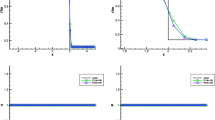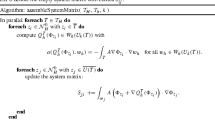Abstract
Level set (LS) method is a widely used interface capturing method. In the simulations of incompressible two-phase flows, in order to avoid discontinuities at interfaces, the LS function is usually taken as a smeared-out Heaviside function bounded on [0, 1] and advected by a given velocity field \(\mathbf {u}\) obtained from the solution of the incompressible Navier-Stokes equations. In the incompressible limit \(\nabla \cdot \mathbf {u}=0\), the advection equation for the LS function can be written and discretized in conservative form. However, due to numerical errors, the resulting velocity field is in general not divergence free which leads to the solution of the advection equation in conservative form does not satisfy the maximum principle. To overcome this issue, in this work, we develop a high-order discontinuous Galerkin (DG) method to directly solve the advection equation for the LS function in non-conservative form. Moreover, we prove that by applying a linear scaling limiter, the proposed method together with a strong stability preserving (SSP) time discretization scheme can satisfy the strict maximum principle under a suitable CFL condition. Numerical simulations of several well-known benchmark problems, including the application to incompressible two-phase flows, are presented to demonstrate the high-order accuracy and maximum-principle-satisfying property of the proposed method.
















Similar content being viewed by others
References
Bahbah, C., Khalloufi, M., Larcher, A., Mesri, Y., Coupez, T., Valette, R., Hachem, E.: Conservative and adaptive level-set method for the simulation of two-fluid flows. Comput. Fluids 191, 104223 (2019)
Yang, X., James, A.J., Lowengrub, J., Zheng, X., Cristini, V.: An adaptive coupled level-set/volume-of-fluid interface capturing method for unstructured triangular grids. J. Comput. Phys. 217, 364–394 (2006)
Osher, S.J., Sethian, J.A.: Fronts propagating with curvature dependent speed: algorithms based on Hamilton-Jacobi formulations. J. Comput. Phys. 79, 12–49 (1988)
Sethian, J.A., Smereka, P.: Level set methods for fluid interfaces. Annu. Rev. Fluid Mech. 35, 341–372 (2003)
Osher, S., Fedkiw, R.P.: Level set methods: an overview and some recent results. J. Comput. Phys. 169, 463–502 (2001)
Olsson, E., Kreiss, G.: A conservative level set method for two phase flow. J. Comput. Phys. 210, 225–246 (2005)
Olsson, E., Kreiss, G., Zahedi, S.: A conservative level set method for two phase flow II. J. Comput. Phys. 225, 785–807 (2007)
Owkes, M., Desjardins, O.: A discontinuous Galerkin conservative level set scheme for interface capturing in multiphase flows. J. Comput. Phys. 249, 275–302 (2013)
W.H. Reed, T.R. Hill, Triangular mesh methods for the neutron transport equation, Los Alamos Scientific Laboratory Report, LA-UR-73-479, 1973
Cockburn, B., Shu, C.-W.: TVD Runge-Kutta local projection discontinuous Galerkin finite element method for conservation laws II: general framework. Math. Comput. 52, 411–435 (1989)
Cockburn, B., Shu, C.-W.: Runge-Kutta discontinuous Galerkin methods for convection-dominated problems. J. Sci. Comput. 16, 173–261 (2001)
Dafermos, C.M.: Hyperbolic conservation laws in continuum physics. Springer, New York (2000)
Zhang, X., Shu, C.-W.: On maximum-principle-satisfying high order schemes for scalar conservation laws. J. Comput. Phys. 229, 3091–3120 (2010)
Zhang, X., Shu, C.-W.: Maximum-principle-satisfying and positivity-preserving high-order schemes for conservation laws: survey and new developments. Proc. R. Sco. A 467, 2752–2776 (2011)
Liu, X.-D., Osher, S.: Nonoscillatory high order accurate self-similar maximum principle satisfying shock capturing schemes I. SIAM J. Numer. Anal. 33(2), 760–779 (2011)
Zhang, X., Shu, C.-W.: On positivity-preserving high order discontinuous Galerkin schemes for compressible Euler equations on rectangular meshes. J. Comput. Phys. 229, 8919–8934 (2010)
Liang, C., Xu, Z.: Parametrized maximum principle preserving flux limiters for high order schemes solving multi-dimensional scalar hyperbolic conservation laws. J. Sci. Comput. 58, 41–60 (2014)
Xu, Z.: Parametrized maximum principle preserving flux limiters for high order scheme solving hyperbolic conservation laws: one-dimensional scalar problem. Math. Comput. 83, 2213–2238 (2014)
Xiong, T., Qiu, J.-M., Xu, Z.: A parametrized maximum principle preserving flux limiter for finite difference RK-WENO schemes with applications in incompressible flows. J. Comput. Phys. 252, 310–331 (2013)
Zhang, Y., Zhang, X., Shu, C.-W.: Maximum-principle-satisfying second order discontinuous Galerkin schemes for convection-diffusion equations on triangular meshes. J. Comput. Phys. 234, 295–315 (2013)
Chen, Z., Huang, H., Yan, J.: Third order maximum-principle-satisfying direct discontinuous Galerkin methods for time dependent convection diffusion equations on unstructured triangular meshes. J. Comput. Phys. 308, 198–217 (2016)
Yu, H., Liu, H.L.: Third order maximum-principle-satisfying DG schemes for convection-diffusion problems with anisotropic diffusivity. J. Comput. Phys. 391, 14–36 (2019)
Du, J., Yang, Y.: Maximum-principle-preserving third-order local discontinuous Galerkin method for convection-diffusion equations on overlapping meshes. J. Comput. Phys. 377, 117–141 (2019)
Xiong, T., Qiu, J., Xu, Z.: High order maximum principle preserving discontinuous Galerkin method for convection-diffusion equations. SIAM J. Sci. Comput. 37, A583–A608 (2015)
Liu, J.-G., Shu, C.-W.: A high-order discontinuous Galerkin method for 2D incompressible flows. J. Comput. Phys. 160, 577–59 (2000)
Li, M., Dong, H., Hu, B., Xu, L.: Maximum-principle-satisfying and positivity-preserving high order central DG methods on unstructured overlapping meshes for two-dimensional hyperbolic conservation laws. J. Sci. Comput. 79, 1361–1388 (2019)
Crandall, M., Majda, A.: Monotone difference approximations for scalar conservation laws. Math. Comput. 34, 1–21 (1980)
Cheng, J., Zhang, F., Liu, T.G.: A discontinuous Galerkin method for the simulation of compressible gas-gas and gas-water two-medium flows. J. Comput. Phys. 403, 109059 (2020)
Cheng, J., Zhang, F., Liu, T.G.: A quasi-conservative discontinuous Galerkin method for solving five equation model of compressible two-medium flows. J. Sci. Comput. 85, 12 (2020)
Cheng, Y., Shu, C.-W.: A discontinuous Galerkin finite element method for directly solving the Hamilton-Jacobi equations. J. Comput. Phys. 223, 398–415 (2007)
Shu, C.-W.: Total-variation-diminishing time discretizations. SIAM J. Sci. Stat. Comput. 9, 1073–1084 (1988)
Liu, H., Yan, J.: The direct discontinuous Galerkin (DDG) methods for diffusion problems. SIAM J. Numer. Anal. 47, 475–698 (2009)
Liu, H., Yan, J.: The direct discontinuous Galerkin (DDG) method for diffusion with interface corrections. Commun. Comput. Phys. 8, 541–564 (2010)
Anderson, R., Dobrev, V., Kolev, T., Kuzmin, D., Quezada de Luna, M., Rieben, R., Tomov, V.: High-order local maximum principle preserving (MPP) discontinuous Galerkin finite element method for the transport equation. J Comput Phys 334, 102–124 (2017)
Zalesak, S.T.: Fully multidimensional flux-corrected transport algorithms for fluids. J. Comput. Phys. 31, 335–362 (1979)
Bell, J.B., Colella, P., Glaz, H.M.: A second-order projection method for the incompressible Navier-Stokes equations. J. Comput. Phys. 85, 257–283 (1989)
Enright, D., Fedkiw, R., Ferziger, J., Mitchell, I.: A hybrid particle level set method for improved interface capturing. J. Comput. Phys. 183, 83–116 (2002)
Owkes, M., Desjardins, O.: A discontinuous Galerkin conservative level set scheme for interface capturing in multiphase flows. J. Comput. Phys. 249, 275–30 (2013)
Guermond, J.L., Salgado, A.: A splitting method for the incompressible flows with variable density based on a pressure Poisson equation. J. Comput. Phys. 228, 2834–2846 (2009)
Guermond, J.L., Quartapelle, L.: A projection FEM for variable density incompressible flows. J. Comput. Phys. 165, 167–188 (2000)
Li, Y., Mei, J.Q., Ge, J.T., Shi, F.: A new fractional time-stepping method for variable density incompressible flows. J. Comput. Phys. 242, 124–137 (2013)
Tryggvason, G.: Numerical simulations of the Rayleigh-Taylor instability. J. Comput. Phys. 75, 235–282 (1988)
Zhang, F., Cheng, J., Liu, T.G.: A direct discontinuous Galerkin method for the incompressible Navier-Stokes equations on arbitrary grids. J. Comput. Phys. 380, 269–294 (2019)
Zhang, F., Cheng, J., Liu, T.G.: A high-order discontinuous Galerkin method for the incompressible Navier-Stokes equations on arbitrary grids. Int. J. Numer. Meth. Fluids 90, 217–246 (2019)
Zhang, F., Cheng, J., Liu, T.G.: A reconstructed discontinuous Galerkin method for incompressible flows on arbitrary grids. J. Comput. Phys. 418, 109580 (2020)
Acknowledgements
This work is supported by National Natural Science Foundation of China (No. 12001020) and China Postdoctoral Science Foundation (No. 2020M680176).
Author information
Authors and Affiliations
Corresponding author
Additional information
Publisher's Note
Springer Nature remains neutral with regard to jurisdictional claims in published maps and institutional affiliations.
A Proof of Theorem 2
A Proof of Theorem 2
Consider an arbitrary order \(P^k\) approximation (\(k\ge 1\)). By using an N-point Gauss-Lobbato and an L-point Gauss-Legendre quadrature rules exact for single-variable polynomials of degree k, we can represent the solution \(\varphi _h(x,y)\) along the line \(y=y_j^\alpha \) (\(1\le \alpha \le L\)) as
Here, \(\varphi _{{\widehat{\beta }},\alpha }\overset{def}{=}\varphi _h(\widehat{x}_i^\beta ,y_j^\alpha )\). Taking derivative once with respect to x results in
Similarly, we have
Here, \(\varphi _{\alpha ,{\widehat{\beta }}}\overset{def}{=}\varphi _h(x_i^\alpha , \widehat{y}_j^\beta )\). Then, the surface integral in Eq. (27) can be further written as
Substituting Eq. (72) into the scheme Eq. (27), it gives
Let us introduce the following formal formulations
Plugging the expression of \(\widehat{f}(\cdot ,\cdot )\) Eq. (25) into Eq. (74), it gives
Then, it is easy to verify that under the CFL condition Eq. (42), \(H_{x,\alpha }^{(1)}\), \(H_{x,\alpha }^{(\beta )}\) \((2\le \beta \le N-1)\) and \(H_{x,\alpha }^{(N)}\) are monotonically increasing with respect to their arguments, i.e.,
Moreover, we have
Similar results can be obtained for
Therefore, \({\overline{\varphi }}_{i,j}^{n+1}\in [m,M]\) under the CFL condition Eq. (42) since it is a convex combination of all the points values involved.
Rights and permissions
About this article
Cite this article
Zhang, F., Liu, T. & Liu, M. A High-Order Maximum-Principle-Satisfying Discontinuous Galerkin Method for the Level Set Problem. J Sci Comput 87, 45 (2021). https://doi.org/10.1007/s10915-021-01459-2
Received:
Revised:
Accepted:
Published:
DOI: https://doi.org/10.1007/s10915-021-01459-2




